As described in Part 1 of this article, after much internal debate and heavy reading on the subject, I decided to build my own HTPC and customize it to my preferences. With the help of a very much appreciated buying guide written by Assassin HTPC Custom Entertainment, I determined the parts needed to create this new, fancy addition to my home theater setup. For anyone interested in such equipment, I highly encourage using the invaluable guide and visiting Assassin’s blog for further assistance. It’s well worth the effort when you end up with an awesome machine that stores all your media and provides quick access to your Blu-rays, music and photos.
As an added bonus, you can also use your HTPC to watch television, HULU, Netflix, VUDU or whatever else you can find over the internet. The biggest surprises to me were being able to bitstream high-resolution audio to my A/V receiver and watch 3D movies, either through a video card or thanks to the latest CPUs with excellent video graphics. Naturally, I went with a build that would allow me to take full advantage my already-existing setup, which Assassin amusingly describes as a “V8 Turbocharged sports car” in his guide. This particular build is based around the Intel i3-2100 processor in the Sandy Bridge line of microarchitectures.
 I was tempted to go with the new i7 for a while, possibly the 2600k, but after asking Assassin about the differences, he explained that unless I plan to do a lot of 3D gaming there’s really no advantage. Besides, that processor is intended more for those who do tons of transcoding — digital-to-digital conversion transfers of data taken from sources like HD cameras. Basically, unless you work in the film industry editing or doing visual effects on 4k digital intermediates, the i7 is overkill. I’d have to spend double the amount without ever actually using the chip to its full potential. In the end, the i3 is really all I need for an outstanding HTPC that doesn’t require too much power and produces even less heat. (As a side note, Intel’s latest processor, codenamed Ivy Bridge, debuts for retail purchase in April and promises better overclocking, less power consumption and true 4k video playback. But again, the benefit is really for i7 users.)
I was tempted to go with the new i7 for a while, possibly the 2600k, but after asking Assassin about the differences, he explained that unless I plan to do a lot of 3D gaming there’s really no advantage. Besides, that processor is intended more for those who do tons of transcoding — digital-to-digital conversion transfers of data taken from sources like HD cameras. Basically, unless you work in the film industry editing or doing visual effects on 4k digital intermediates, the i7 is overkill. I’d have to spend double the amount without ever actually using the chip to its full potential. In the end, the i3 is really all I need for an outstanding HTPC that doesn’t require too much power and produces even less heat. (As a side note, Intel’s latest processor, codenamed Ivy Bridge, debuts for retail purchase in April and promises better overclocking, less power consumption and true 4k video playback. But again, the benefit is really for i7 users.)
The next logical step is deciding on a good quality motherboard with an LGA1155 socket, since Sandy Bridge was my choice of processor. Assassin recommends either the H67 or Z68 chipsets, which will take advantage of the CPU’s integrated HD graphics, eliminate the need for a separate video card, and in turn keep costs down. Both chipsets are quite similar, but the Z68 is best suited for gamers due to the excellent overclocking, the SSD caching feature and the ability to add a high-performance graphics card alongside the CPU. For non-gaming home theater enthusiasts, the H67 build is perfect for a dedicated HTPC. Since I have a preference for motherboards by ASUS, I went with the P8H67-M EVO.
What sold me on this particular model was the fact that it comes fully loaded with by far the most user-friendly BIOS interface I’ve ever experienced. It has no need for any software updates. It comes ready to handle high-resolution audio in 8 separate channels via HDMI or 5.1 through the analog ports, which music audiophiles can use instead for 2-channel stereo. The model also includes an eSATA port, which will come in handy for future use. Best of all, it natively supports hard drives larger than 2.2TB without having to partition them as GPT. (The MBR partition style of other motherboards is limited to recognizing only 2TB of storage space or less.)
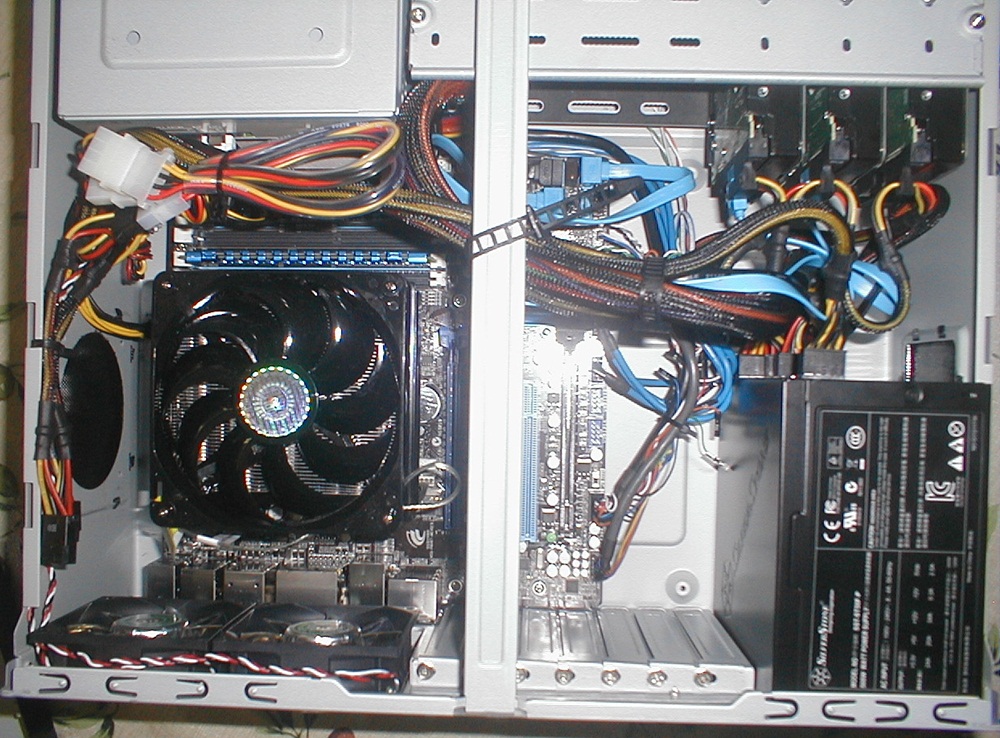 After buying a pair of G.Skill Ripjaws for 4GB of memory, I purchased another pair of 3TB hard drives from Western Digital’s Caviar Green line. I know they’re big, but believe me they’ll get filled very quickly. I’m also now a convert for SSDs (Solid State Drives), and cannot recommend them enough. The difference in boot-up is simply amazing while the rest of the system runs super smooth and fast at a whisper-quiet noise level. They’re very much worth the added price. I went with the Crucial M4 64GB, dedicated only for the operating system and minor software programs. The other two HDDs are for the storage of movies and music. Then I ordered the Strider Plus modular PSU (power supply unit) from Silverstone because it allows the removal of unused cables and less clutter.
After buying a pair of G.Skill Ripjaws for 4GB of memory, I purchased another pair of 3TB hard drives from Western Digital’s Caviar Green line. I know they’re big, but believe me they’ll get filled very quickly. I’m also now a convert for SSDs (Solid State Drives), and cannot recommend them enough. The difference in boot-up is simply amazing while the rest of the system runs super smooth and fast at a whisper-quiet noise level. They’re very much worth the added price. I went with the Crucial M4 64GB, dedicated only for the operating system and minor software programs. The other two HDDs are for the storage of movies and music. Then I ordered the Strider Plus modular PSU (power supply unit) from Silverstone because it allows the removal of unused cables and less clutter.
After that, I still needed to pick out the computer case I wanted. This is definitely the most subjective part of the build process because it’s a completely aesthetic choice. Some might like a tower case that stands nicely next to a desk, or maybe a small, space-saving desktop. Others, such as HT hobbyists with OCD like myself, might prefer something that blends in with the rest of the equipment and looks just like another piece of hardware. There are many companies out there that specialize in this area, like nMediaPC, Thermaltake and Lian Li. Personally, I love the look of Silverstone products, so I purchased the LC20 model in black without the optional remote. Then I added a wireless adapter card for internet purposes, of course, and installed a Blu-ray burner from Lite-On.
Finally, with everything put in place and built, I purchased a standard size wireless mouse and keyboard. I could’ve gone with one of those nice RF keyboards by Lenovo, but I don’t really care about something so small. Needless to say, these are necessary components for regular PC use and operations, like updates, internet, program functions and so forth.
I also wanted a separate media center remote, so I bought the affordable Windows MCE remote with an infrared receiver that plugs in via any available USB port. After customizing the power options on my new HTPC, changing power buttons to sleep and hibernate instead of shutdown, I programmed my Harmony One to communicate with the small IR dongle. (I’ll give details on this aspect in a later post.) I absolutely love this part of my new setup. I can control the computer along with everything else from a single remote. It’s awesome! Next time, I’ll explain the process for ripping my movies and the final end result with screengrabs and video.

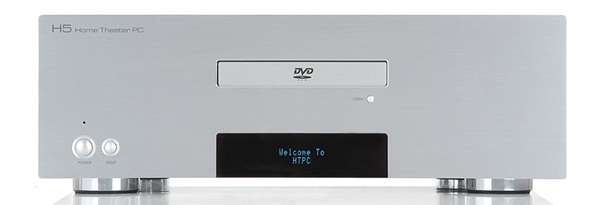
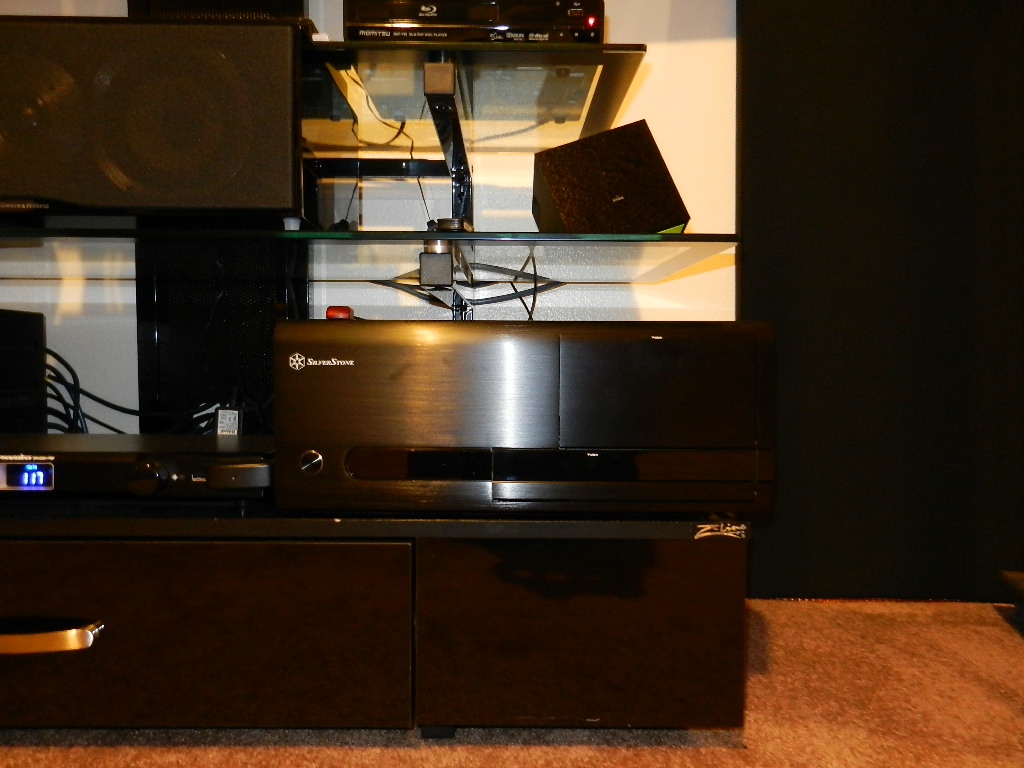


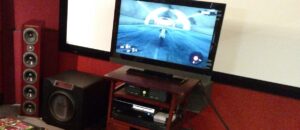
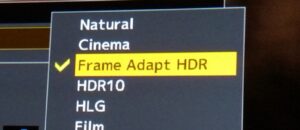
August Lehe
Too bad your HTPC discussion flies miles over my head! Of course, after a few years, I will re-read this and wonder how quaint? Is the first HTPC article still easy to access? My wife is one of those “No computers in this house! And nothing hooked up to the phone line!” I’m afraid a Yamaha 871 3-D Receiver is about as far as she will let me go in 2012 or 2013!
Javier
Im using a popcorn hour A-110 which has been serving me well so far. Once I finish acquiring all my other equipment Ill start building my own htpc
Tom M.
I didn’t read this whole thing, but my “HTPC” has been a 2009 Mac Mini with 4Gb of RAM, with optical cable connected from the digital/analog headphone jack to my HT receiver, and a monitor port-to-HDMI cable connected to my HDTV. And I use the $5 Rowmote Pro app (virtual glidepad + keyboard) on my iPad (or iPhone) to control the Mac.You can also buy an eyeTV USB dongle for using the Mac as a DVR.
This solution was less than $1000 (even with the addition of an additional 1.5Tb external hard drive for storage), and I didn’t have to fuddle for hours with creating (and configuring) a PC from the ground up.
M. Enois Duarte
AuthorYour right. There are a variety options available for different users, a topic I covered in a previous article (http://www.highdefdigest.com/blog/htpc-media-server/). I admit it doesn’t touch on everything, but I tried to fit as much as possible without making it too long. And Javier mentions Popcorn Hour, which are great little machines.
I went this route because I love to be very hands-on with my projects and configure the whole thing exactly to my desires. Sure, it took me hours to build (and I continue to work on it) but I enjoyed every minute of it. It’s what makes it such a fun hobby.
assassin
A HTPC is the ultimate gadget.
Owen
I’m currently considering buying the Dune HD Max player but here in the UK it sells for around £369 or about $570 (without a hard drive) and i was wondering if anyone else has one or used one and would know if it is worth the money?
Tom
You may want to think about waiting for Ivy Bridge or using a dedicated video card. Sandy bridge has a problem. See quote:
One of the biggest failings with the Clarksdale-based Core i series CPU’s was that they could not use a resolution of 23.976 Hz, which is necessary to view Blu-Ray properly as most of modern movies currently are released with that refresh rate. Instead, the CPU’s output a 24 Hz. When we watch a movie filmed in 23.976 fps (23.976 Hz) at 24 Hz, it means that every 40 seconds, an extra frame must be inserted to sync the audio, meaning we get a slight judder in the image, mostly visible if the image is panning at that point
assassin
There’s no proof that Ivy Bridge will fix this “bug”. Intel now is about as good as any of the discrete cards.
http://www.avsforum.com/avs-vb/showthread.php?t=1333324
Many people don’t notice or care about the “24p bug” anyway. Its at worst 1 missed frame in about a 1000 and at best about 1 missed frame in 10,000. And if you have a HDTV that doesn’t have a 24p mode then its impossible for you to notice it anyway.
William Henley
Yeah, mine outputs at 24Hz too, and quite frankly, I don’t notice the judder – if its ther, its too minute. In fact, its only been in the last few weeks that I found out that movies are filmed at 23.976fps and not 24fps. I have been using my TV as a display for years, and can honestly say that I have ever noticed this.
Of course, it is possible that my card is displaying 23.976 when it says its displaying 24Hz, so I won’t throw that out.
Jon
Actual film movies are shot at a full 24fps (not sure about digitally shot movies). The NTSC specs don’t allow for this framerate to be exactly reproduced, so they slightly slow it down to 23.976fps when a film is transferred to video.
William Henley
Can you touch on the wireless keyboard you are using? I have had three in the past, and they were complete junk, usually not working more than 2-4 feet from the reciever. I need something that will work at a range of about 10 feet. I am also looking at probably getting a wireless trackball. I was originally thinking of this one:
http://www.amazon.com/exec/obidos/ASIN/B00006B9CR/panandscathed-20
But I then I saw this one, and think it would be better suited for sitting on the couch:
http://www.amazon.com/exec/obidos/ASIN/B0056Y8C2I/panandscathed-20
I got an MCE remote, so I do have some control over my mouse pointer with it.
M. Enois Duarte
AuthorA friend from a few years back owned a similar Logitech track ball and loved it. I’m not sure about the second choice although it looks comfortable and the range should work for you.
I went with the more traditional look, the Microsoft Wireless Desktop 3000 (which is also available without the mouse)
http://www.amazon.com/exec/obidos/ASIN/B001S4OTS6/panandscathed-20
I also sit about ten to eleven feet away, and the keyboard/mouse I’m using has been flawless so far. I did buy it on sale though when I walking through Fry’s. The majority of my viewing, however, is with the use of my Harmony remote. The keyboard/mouse is mostly for working the programs, ripping movies, surfing the net and such.
William Henley
I have the wired version of this trackball and love it. Had it for years. In fact, its a PS/2 device. That should tell you how old it is. Those Logitech trackballs are built to last! Still thinking about going with the hand one for the TV. Yeah, the remote works fine if I am just watching movies, but there are times I want to do other stuff, and just do not want to sit in front of my monitor.
Thanks for the info on the keyboard. This looks exactly like what I am looking for.
assassin
I have a free sticky thread over at avs which lists my favorite remote controls and remotes with keyboards.
William Henley
Can you post the link?
M Enois Duarte
I included the link in the first paragraph of the article, William. The part where it reads “buying guide.”
William Henley
Oh, I thought it was a different AVS forum link. My bad
William Henley
That Rii Touch looks perfect for me! I am still evaluating my options, though. Trying to decide if I want to play games on my bigscreen tv. If I decide to do that, I may end up going with a standard keyboard and trackball.